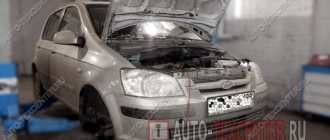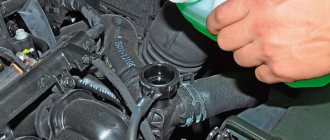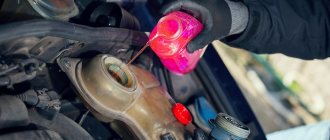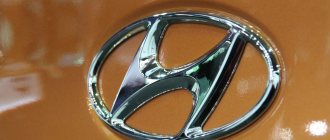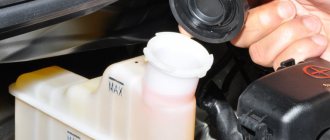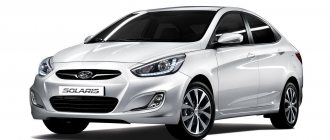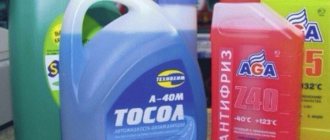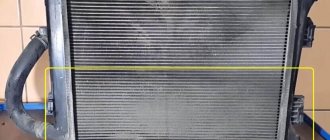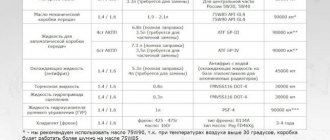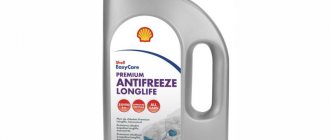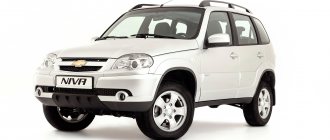The cooling system of an internal combustion engine requires regular and correct maintenance. At the same time, scheduled maintenance often involves replacing the coolant, as well as checking the performance and condition of individual elements (pipes, pump, thermostat, etc.).
At the same time, the Gamma power plant on the Hyundai Solaris is no exception. The cooling system must be carefully monitored and properly maintained. Next, we will look at what a simple car enthusiast can do, how to choose antifreeze for Solaris, as well as when to change the coolant, how often to replace it and what to pay attention to.
What kind of antifreeze do manufacturers pour into Hyundai?
Coolant of the same color (green) is poured into all brands of Hyundai cars.
Not to be confused with G11. However, there are minor discrepancies that depend on the country in which the car is assembled. Hyundai cars produced in Russia are filled with coolant from Mobis Parts CIS LLC. This composition is branded R9000AC001Н and is poured into a white 1 liter container. On the bottle there is a Hyundai or Kia symbol and the inscription “Crown LLC A-110 Antifreeze,” phosphate-carboxylate class. The coolant is produced according to the methods of the Kukdong company from Korea. It contains ethylene glycol, demineralized water and a special concentrate AC-110. Typically, such coolant is purchased for topping up. There is no need to mix it with distilled water in advance.
KIA cars are filled with exactly the same liquid, which is produced under the brand name R9000AC001K, where the letter “K” indicates a KIA car. The compositions for both Hyundai and Kia are absolutely the same. The coolant base is ethylene glycol, because both cars have an aluminum radiator. Antifreeze for both brands of cars is made according to the Hyundai/Kia MS591-08 and JIS K 2234 specifications. The only difference is in the cost of the coolant.
The genuine composition of Hyundai/Kia Long Life Coolant (concentrate), which is not produced in the Russian Federation, has the mark 0710000200 (volume 2 l) or 0710000400 (volume 4 l). The manufacturer is KUKDONG JEYEN COMPANY LTD. The liquid is made on the basis of phosphate ethylene glycol, which contains a minimum amount of amines, borates, nitrites, silicates, but it is classified as silicate. A distinctive feature is the shelf life of 2 years (Coolant 2yr). Although the manufacturer advises filling a Hyundai with new coolant no more than once every ten years. Such contradictions in the recommendations are caused by the fact that during long-term storage in a container with liquid, sediment may appear.
The South Korean manufacturer sells coolant for Hyundai in the form of a concentrate, which should be diluted with distilled water in a one to one ratio before use. This ratio allows the use of antifreeze at a temperature of -37 °C. If you combine 60 parts of concentrate and 40 parts of water, then it is possible at -52 °C. In areas where the temperature does not drop below -26°C, the ratio of liquids is used in reverse proportion. Depending on the ratio, you can change the lower temperature value. Typically, this composition is used if you plan to completely replace the coolant.
Coolant selection
Hyundai Solaris 2017
Catalog numbers of consumables for replacement:
Original Hyundai/Kia antifreeze 0710000400 “Hyundai Long Life Coolant” (concentrate) 4-liter refill canister will cost about 1,300 rubles. Hyundai/Kia antifreeze “Crown LLC A-110”, JIS K 2234 standard, liter bottle item number R9000AC001H, costs 350 rubles.
Related analogues: Ready-to-use red antifreeze g12 Patron AFRED5PATRON (PE canister) 5 kg or Patron AFGREEN5PATRON green liquid g12, 5 l canister. Price 540 rubles. Antifreeze TCL “LLC −50C”, green, 4 l. Comrade code LLC01229 — 1100 rub.
When to change coolant on Solaris
As mentioned earlier, the first coolant replacement on a Hyundai Solaris occurs in the first 210,000 km or 10 years of operation of the car (in total, TO14 is obtained). Subsequent fluid changes should occur every 45,000 km or 36 months. Although in reality you will have to do this much earlier, because during this time the pump or even the radiator will probably be changed.
It is recommended to replace the coolant at a service station or an authorized HYNDAI dealer.
When adding coolant, it is necessary to add only deionized or low-salt water to the car, but never hard water. Foreign antifreeze will also most likely lead to serious damage or failure of the engine.
How to check the quality of new antifreeze?
The main disadvantages of the Hyundai Solaris
Unfortunately, the situation on the market today is such that when buying even a well-known brand, it is advisable to check the quality of the purchase. Fortunately, this is very easy to do - just heat the liquid to a boil and see at what temperature it boils. It has been noticed that all the raw materials boil very early, but the high-quality ones do not boil before 107 degrees C at atmospheric pressure.
The temperature can be measured using, for example, a multimeter or an infrared thermometer
An infrared thermometer can give an error in the range from 3 to 7 degrees. This needs to be kept in mind.
Only 95, sometimes even below 90
If you do not check the liquid by temperature, check it visually by color. Counterfeit goods, as a rule, always very quickly lose their original color and become colorless or brown.
Reason to think about replacing
If you are unlucky with antifreeze or you have already bought a car with such liquid, the system needs to be flushed. How to do this is written below.
Leaks and problems
Hyundai Solaris does not have any particular problems with the cooling system. Unless the filler cap should be changed periodically. Since sometimes the bypass valve located in it fails. This creates increased pressure, which sometimes leads to leaks at the joints.
Sometimes users may complain about increased engine temperature; this can be treated, as it turns out, by externally flushing the radiator. Over time, dirt gets into the small cells, which disrupts normal heat exchange. As a rule, this happens on older cars that have had time to travel in various conditions.
Replacement frequency, what antifreeze to fill
Hyundai Solaris reviews
According to the manufacturer’s regulations, the first replacement for a Hyundai Solaris should be made after a mileage of no more than 200 thousand kilometers. And with low mileage, the service life is 10 years. Further replacements depend on the fluid used.
According to the recommendation of the automobile concern, you need to use original Hyundai Long Life Coolant antifreeze to fill the cooling system. It comes as a concentrate that must be diluted with distilled water.
The original liquid comes in several forms, in a gray or silver canister with a green label. It must be changed every 2 years. At one time it was the only one recommended for replacement. Since then, information has been floating around the Internet, which is what needs to be used. But at the moment it is not advisable to use it, since it is created on an outdated silicate base. But just in case, here are the order codes 07100-00200 (2 l.), 07100-00400 (4 l.)
Now for replacement you should choose antifreeze in a green canister with a yellow label, which is designed for 10 years of operation. At the moment, this will be the best option, as it fully meets modern requirements. Complies with Hyundai/Kia MS 591-08 specification and belongs to lobride fluids and the phosphate-carboxylate (P-OAT) class. You can order using these articles 07100-00220 (2 l.), 07100-00420 (4 l.).
How much antifreeze is in the cooling system, volume table
| Model | Engine capacity | How many liters of antifreeze are in the system | Original liquid / analogues |
| Hyundai Solaris | gasoline 1.6 | 5.3 | Hyundai Long Life Coolant |
| gasoline 1.4 | Crown LLC A-110 | ||
| CoolStream A-110 | |||
| RAVENOL HJC Hybrid Japanese Coolant |
There is nothing complicated about how to change the coolant on a Hyundai Solaris. The first step is to purchase the required amount of antifreeze. For Solaris it is 5.3 liters. In addition to the antifreeze itself, you will need to acquire containers for draining. The engine must cool completely before the replacement process.
Further work is carried out in the following order:
It is necessary to get rid of too much pressure in the system. To do this, remove the tank cap and radiator cap. To the left of the engine and slightly behind it there is a shield that serves to protect the power plant from dirt
It needs to be dismantled. Access to the drain valve opens, which should be carefully unscrewed, but not all the way, leaving 1-2 turns. This will significantly reduce the pressure intensity and the amount of liquid drained.
Place a container of the required volume under the tap. At this stage of work, it may turn out that the sealing ring on the tap is deformed, cracked and requires replacement. It needs to be replaced. Assuming the presence of this risk, it is better to buy the necessary part according to the corresponding catalog article before changing the antifreeze. After, according to calculations and the volume of the filled vessels, almost all the antifreeze has leaked out, the remaining antifreeze must be removed using a syringe or a syringe bulb. The tap is screwed in and fixed. Next, coolant is poured into the tank until it reaches the level indicated by the letter “L”. After closing the tank with the cap, the car starts.
At this moment, the fan may unexpectedly work, which indicates that the automation has diagnosed the problem. The antifreeze level has dropped. The engine is turned off and the fluid is added to the required volume.
The resulting air lock in most cases goes away on its own after an hour or two of use.
Let's sum it up
Taking into account the above information, it becomes clear that only the latest generations of antifreeze are suitable for Hyundai Solaris. At the same time, you should not fill in both the cheapest G11 and the expensive G13. It is optimal to opt for G12, G12+ or G12++. The only thing is that it is also advisable to separately take into account the individual features and properties of these liquids in order to select the most suitable option.
We also recommend reading the article about which antifreeze to choose, G11 or G12. From this article you will learn what the differences are between these classes of antifreeze, as well as which fluid is best to choose for the cooling system of different cars and why.
Finally, we note that provided that Hyundai Solaris antifreeze is correctly selected and regularly replaced, the cooling system of this car is highly efficient and stable. In turn, this is reliable protection of the power plant from general or local overheating, which significantly increases the life of the internal combustion engine.
Stages of replacing Hyundai Solaris coolant
When replacing antifreeze on this model, it is necessary to flush the cooling system, since there is no drain plug on the engine block. Without flushing, some of the old fluid will remain in the system, which will worsen the properties of the new coolant.
There are several generations of Solaris, they do not have any fundamental changes in the cooling system, so the replacement instructions will be applicable to all:
- Hyundai Solaris 1 (Hyundai Solaris I RBr, Restyling);
- Hyundai Solaris 2 (Hyundai Solaris II HCr).
The procedure is best carried out in a garage with a pit so that you can easily get to all places. Without a hole, replacement is also possible, but getting there will be more difficult. Gasoline engines of 1.6 and 1.4 liters were installed on Solaris. The volume of antifreeze poured into them is approximately 5.3 liters. The same engines are used on the Kia Rio, where we described the replacement process without a hole.
Coolant drain
You need to change the coolant on a cold engine, so while it is cooling, there is time to remove the protection. You will also need to remove the protective plastic shield on the right side, as it blocks access to the radiator drain plug.
During this time, the car has cooled down, so we proceed to the draining itself:
- On the left side of the radiator we find a drain plug, under this place we place a basin or a cut plastic canister to collect the old fluid.
We unscrew it, sometimes it gets stuck, so you have to apply force to break it off (Fig. 1). Fig.1 Drain plug on the radiator - As soon as the liquid begins to drain, the stream will be small, so unscrew the plug on the radiator filler neck.
- On the opposite side of the radiator we find a thick pipe, remove the clamp from it, tighten it and drain it (Fig. 2).
In this way, part of the fluid will drain from the block; unfortunately, it will not be possible to drain the rest from the engine, since there is no drain plug. Fig.2 Pipe with clamp - All that remains is to empty the expansion tank; for these purposes you can use a rubber bulb or a syringe with a hose attached to it.
After completing the draining procedure, do not forget to put everything in its place. Next we move on to the washing stage.
Flushing the cooling system
To flush out the remnants of old antifreeze from the cooling system, we need distilled water. Which needs to be filled into the radiator to the top of the neck, as well as into the expansion tank between the minimum and maximum levels.
When the water is filled, close the radiator and tank caps. Next, we start the engine, wait until it warms up, and when the thermostat opens, you can turn it off. Signs that the thermostat is open and water is circulating in a large circle is that the cooling fan is turning on.
When warming up, it is necessary to monitor the temperature readings so that it does not rise to very high values.
After this, stop the engine and drain the water. Repeat this several more times until the drained water is clear.
Distilled water and antifreeze should be drained when the engine is cool. Otherwise you may get burned. And also with sudden cooling and temperature changes, the block head may become deformed.
Filling without air pockets
After flushing, approximately 1.5 liters of distilled water remains in the Hyundai Solaris cooling system. Therefore, it is recommended to use concentrate, rather than ready-made antifreeze, as a new fluid. It can be diluted with this in mind to maintain the desired freezing temperature.
New antifreeze should be added in the same way as distilled water for flushing. The radiator is up to the top of the neck, and the expansion tank is up to the top strip, where the letter F is. After that, we install the caps in their places.
We turn on the ignition and wait until the car engine warms up. You can increase the speed to 3 thousand for a minute so that the pump disperses the liquid through the system faster. This will also help air escape if there is an air lock in the cooling lines.
After this is done, turn off the engine and let it cool a little. Now you need to carefully open the filler neck and add the required amount of liquid. Since during warming up it was distributed throughout the system and the level should have decreased.
Several days after replacement, it is necessary to check the antifreeze level and top up if necessary.
What antifreeze is in the Solaris cooling system from the factory?
This antifreeze is poured into domestically assembled Solaris.
If you look through the manual, it will not give a specific answer on the brands of coolant. There they will write that the volume of the cooling system of both engines is 5.3 liters, and you need to pour a mixture of ethylene glycol concentrated antifreeze and distilled water in a one-to-one ratio.
- From the assembly line in Korea, Solaris is filled with Hyundai Long Life Coolant with Korean specification MS-591-08.
They pour such antifreeze on foreign Solaris, with funny hieroglyphs on the packaging
- Russian-assembled cars can be filled with CoolStream A-110 or Crown LLC A-110 antifreeze (catalog number R9000AC001K).
The back side shows the article number.
Both of these liquids are produced in the Russian Federation, so the price for them suits the manufacturer. Original Hyundai fluid is also on sale, but costs much more.
The plant strongly discourages the use of antifreeze of other brands, much less of lower quality, and in this it is absolutely right. That's why.
What antifreezes should not be poured?
All modern coolants are divided into several categories based on composition. In short, antifreeze not only does not freeze in the cold, but also has a number of important functions:
- it lubricates the pump;
- does not cause engine corrosion;
- does not boil at temperatures of 130-140 degrees;
- flushes the cooling system;
- does not form foam.
The liquid obtains these properties thanks to the main component and, of course, additives. So, based on the type of main component, antifreezes can be:
- Ancient antifreezes based on sodium nitrite, trisodium phosphate and other nitrites. They are painted blue; such liquids do not contain additional corrosion inhibitors that can resist the destruction of aluminum at high temperatures. The most famous unfortunate liquid from this company is the Soviet Antifreeze. Pouring such antediluvian antifreeze into a modern engine is a death sentence for the cylinder block, radiators and cylinder head. Such antifreezes have a particularly detrimental effect on diesel engines.
Regular Antifreeze is not recommended for use on Hyundai Solaris.
- Silicate-based antifreezes. Silicates are salts of silicic acid, roughly speaking, liquid glass. More modern fluids with a minimal set of additives, but they have a big drawback - over time, they leave a coating on the walls of the cooling system about half a millimeter thick, and this greatly impairs the heat transfer of the engine. In addition, during operation, quartz sediment and sand may fall out, but it will work as a good abrasive. Goodbye pump.
- The most modern antifreezes are carboxylate. Protection of aluminum and engine alloys from corrosion is achieved through organic acids. This antifreeze leaves virtually no traces behind, lasts longer than others, but also requires timely replacement, since as the fluid ages, its anti-corrosion properties sharply decrease.
According to the modern classification (from the WAG company), the last two categories of antifreeze are divided into five groups - G11, G12, G12+, G12++, G13.
The manufacturer does not recommend pouring such antifreeze into Solaris.
Antifreeze recommended by the factory for use
The color of the original antifreeze from the factory is green. The same antifreeze in the package recommended by the manufacturer.
Any antifreeze that we meet in the store has a certain color. Its color is not a determining factor, it is simply a dye, thanks to which we can distinguish one class of liquid from another.
They are typically red in color, but G12++ fluids may be pink or purple in color. In this case, the brand does not matter much.
What to choose?
Where the antifreeze is located, it’s clear what it does too. But which one should you choose for the Hyundai Solaris? In order not to follow the manufacturer’s lead, you need to independently understand all the nuances of such liquids. Otherwise, you can waste your money on a fairly expensive product. So, for example, 10 liters of not the best antifreeze costs about 500 rubles.
Any coolant has its own class, there are 3 of them. It’s worth noting right away that you need to pay attention to them. The best class of them will be useful not only for the Hyundai Solaris, but also for any other car.
1st class – G11. The lowest class indicates the worst coolants, for example, those that contain few different additives. However, these additives may have anti-corrosion and lubricating properties.
The next class is G12. This coolant is already much better than its predecessor, since it contains ethylene glycol and carboxylate compounds. Such antifreeze can form an anti-corrosion film only in places where hot spots are located, so heat removal does not lose its effectiveness.
Class G13. In terms of its properties, objectively, it is the best class of antifreeze of all those currently on the market. It contains polypropylene glycol, which makes it environmentally friendly and non-toxic. That's all. The obsession with safety, of course, is associated with high European standards, which are now sweeping Russia.
When to change antifreeze in Solaris?
Factory recommendation: First replacement 210 thousand km or 120 months. Then every 30 thousand km or 24 months.
Our recommendation is slightly different: If you plan to drive after 200 thousand km and, if possible, avoid problems with the pump, then it is advisable to replace the fluid earlier. . Why? Let's figure it out.
- In the manual, the resource is considered in time and mileage. If there are no questions by time, then the mileage figure needs clarification. When the car is mainly driven on the highway, without being in city traffic jams, you can focus on mileage, but usually the opposite is true. In this case, the engine operating time - engine hours - increases significantly and by 200 thousand km the antifreeze already loses a significant part of its properties. It is necessary to take into account that in traffic jams the coolant temperature is higher than on the highway. The difference is almost 10 degrees. You can notice how often the radiator cooling fan comes on during hot weather. Sometimes it works almost non-stop. All this negatively affects the life of the liquid.
- As for the entry in the manual: Then every 30,000 km or 24 months. The entry is strange and only valid if the cheapest coolants are used. If you use high-quality products, such a recommendation will not be correct. The timing and periods of replacement can be significantly extended.
- Another point that is also important is the cleanliness of the radiators. This does not mean inside, but outside - the radiator honeycombs themselves. We have two radiators in front. First the air conditioner radiator, then the main one. If they are clogged, this also affects the operating temperature of the fluid, and therefore its service life.
The bottom of the radiator is clogged with dirt
- Check whether you have radiator protection and in what condition it is. Small plastic part under the bumper.
Without it, radiators clog much faster.
Useful tips
Please note that even the most modern classes of antifreeze need to be changed. In practice, it is recommended to completely update the G12 and G12+ compounds every 3-4 years of operation or 60-80 thousand km. mileage In other words, Solaris antifreeze is not filled for the entire service life of the car and also needs to be replaced.
As for replacing antifreeze itself, it must be borne in mind that mixing antifreeze from different manufacturers is strongly not recommended. This means that even when liquids of the same class are conditionally compatible (for example, G12), they should not be mixed with each other unless absolutely necessary.
Also, after mixing or when replacing the factory antifreeze with some other one, it is recommended to completely flush the cooling system. The fact is that when replacing, it is not possible to completely drain the old antifreeze, the remains of which are then mixed with fresh liquid.
The most popular engine for Hyundai Solaris
Gamma engines divide this line almost in half, but still, the G4FC engine “withstood” a little more configurations. They are very similar to each other. The FC engine was “increased” in displacement from 1396 to 1591 cubic centimeters, increasing the free stroke of the piston. The year of birth of the unit is 2007. The assembly place is the Hyundai automobile plant in the capital of China, Beijing.
Inline four-cylinder fuel-injected engine producing 123 hp. designed to meet Euro 4 and 5 environmental standards. Fuel consumption (for the option with a manual transmission):
- in the city - 8.0 l.;
- outside the city - 5.4 liters;
- combined - 6.4 l.
The motor has a number of design features characteristic of modern Korean engines:
- distributed injection of the MPI type (multipoint multi point injection);
- the cylinder block and head are made of light and durable aluminum alloy;
- plastic intake manifold;
- two camshafts (DOHC);
- chain drive with tensioner in the timing mechanism.
Of particular interest is the multipoint distributed injection system installed in the engine. It has five main structural elements:
- Throttle valve.
- Ramp (main) for fuel distribution.
- Injectors (nozzles).
- Air consumption (or pressure/temperature) sensor.
- Fuel regulator.
The operating principle of the system is quite simple. The air passes through the atmospheric filter, mass flow sensor and throttle valve into the intake manifold and engine cylinder passages. Fuel comes to the injectors through a ramp. The proximity of the intake manifold and injectors minimizes gasoline losses.
More on the topic: Hyundai Solaris tires: standard and permissible tire sizes, pressure
Control is carried out using the computer. The computer calculates the mass fractions and quality of the fuel mixture based on load, temperature, engine operating conditions and vehicle speed. The result is electromagnetic pulses for opening and closing the injectors, supplied at a certain moment from the control unit.
MPI injection can operate in three modes:
- simultaneously;
- in pairs;
- individually.
The advantages of this fuel injection scheme include efficiency and full compliance with environmental standards. But those who prefer to buy a car with an MPI engine should forget about dashing high-speed driving. Such engines are much more modest in terms of power than those in which the operation of the fuel system is organized according to the principle of direct supply.
For the G4FC, Hyundai has set a fairly low mileage threshold - 180 thousand km (10 years of operational use). In real conditions, this figure is much higher. Various sources provide information that Hyundai Solaris taxis cover up to 700 thousand km. mileage A relative disadvantage of this engine is the lack of hydraulic compensators as part of the timing mechanism, and the need to adjust the valve clearances.
Overall, the G4FC proved to be an excellent motor: light in weight, inexpensive to maintain and unpretentious. However, it is worth considering that from the point of view of major repairs, this is a one-time item. All that can be done on it is plasma spraying of cylinders and boring to the nominal size. However, is it necessary to think about what to do with an engine that can easily “travel” half a million kilometers is a rhetorical question.
More about Solaris
- General information about the Hyundai Solaris
- Solaris engine overhaul
- Weaknesses of Solaris. Main problems of Hyundai Solaris: Infographics.
- Hyundai Solaris Body Dimensions - Dimensions Tables
- How serious are the problems of the Hyundai Solaris?
- Tuning Hyundai Solaris with your own hands: interior, optics, chip tuning
- Hyundai Solaris 2022: Comfort package
- Hyundai Solaris 2022 - photos and prices, videos, characteristics of the new Hyundai Solaris 2
- We bring the updated Hyundai Solaris into the lair of competitors. Test drive hyundai solaris - DRIVE
- Hyundai Solaris 1.4, 1.6 fuel consumption per 100 km
Which product is better to use?
Car manufacturers recommend using the following types of antifreeze:
- Hyundai Long Life Coolant is an original concentrated product and is used for equipment assembled in Korea. Available in 2 liter and 4 liter containers.
- Crown LLC A-110/Coolstream A-110 is completely ready for use and does not require dilution. This antifreeze is bottled in domestically produced cooling systems and is found in 1 liter containers.
To distinguish it from analogues, green dyes are added to the composition.
Consequences of mixing liquids of different brands
Before adding the product to an open expansion tank, the car owner is advised to make sure what kind of antifreeze was used previously. When mixing different grades, destruction of sealing materials may occur, as well as corrosion on metal surfaces.
The documents for the automotive equipment of this model indicate the specific composition of the product. It contains ethylene glycol and distilled water, as well as special additives to increase the beneficial properties of the liquid.
You cannot pour antifreeze or antifreeze of the G11 standard into Solaris. You can use fluids belonging to the G12+, G12++ and G13 standards.
Antifreeze replacement frequency
Directly complete replacement is carried out after a certain time has elapsed, or as a result of passing the required mileage. If this operation is ignored, unwanted deposits may appear inside the system, as well as early boiling of antifreeze in the radiator or tank.
- The car manufacturer recommends the first replacement of the product after traveling 200 thousand km, and also if 10 years have passed since the car left the factory.
- Subsequent replacements are carried out every two years, or after 30 thousand kilometers.
How to drain?
When replacing Hyundai Solaris antifreeze, there is no need to use additional equipment or special devices. The manipulations can be carried out independently in a private garage.
First, purchase a liquid with a capacity of 4 liters. Next, you need to carry out the following manipulations:
- remove the plastic engine protection;
- start the car, heat the engine until the thermostat opens;
- Leave the cooling system filler cap closed. It is located on a special tee;
reach to the tap at the bottom of the radiator and unscrew it 2 turns.
- in this case, you should substitute a container for the used product;
- It is better to remove the cap from the filler neck at the end of the drain;
- drain the antifreeze from the block and radiator;
- Using a syringe with a piece of hose at the tip, remove any remaining liquid from the expansion tank.
How to fill?
You need to tighten the drain valve and fill the coolant through the neck of the cooling system using a funnel.
After filling the system, close the filler neck with the cap. Next, pour antifreeze into the expansion tank 3-5 cm above the “L” mark and close the lid.
Start the engine and warm up to operating temperature. After warming up, if necessary, add antifreeze to about.
All replacement is complete. Check the coolant level occasionally and top it up when hot.
Cooling system
To better understand which fluid is suitable for Hyundai Solaris, you need to understand what it consists of. Or rather, the part where antifreeze will be poured. But you need to start not so much with the system itself, but with its main component - the coolant. It consists of ethylene glycol, as well as special additives. The least important components include dyes and water.
Thanks to this composition, this liquid never freezes, even during extremely cold weather. The freezing point of antifreeze is much lower when compared to water. That is why it is strictly forbidden to pour water into the Hyundai Solaris, or into any other car. Coolant circulates through the engine jacket, so freezing can lead to dire consequences.
